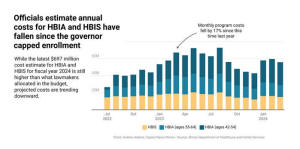Immigrant advocates tout new report showing benefits of state-funded
health plans
 Send a link to a friend
Send a link to a friend
[April 27, 2024]
By PETER HANCOCK
and JERRY NOWICKI
Capitol News Illinois
news@capitolnewsillinois.com
 SPRINGFIELD – Immigrant rights advocates on Friday continued to push for
one of their top budget priorities: full funding for state-run health
care programs that benefit noncitizens, regardless of their immigration
status. SPRINGFIELD – Immigrant rights advocates on Friday continued to push for
one of their top budget priorities: full funding for state-run health
care programs that benefit noncitizens, regardless of their immigration
status.
Those programs offer health coverage for low-income individuals who
would otherwise qualify for Medicaid if not for their immigration
status. They have been the source of controversy in the General
Assembly, especially after the initial cost of the programs far outpaced
the original estimates, forcing Gov. JB Pritzker’s administration to
begin capping enrollment and instituting other cost-cutting measures
last year.
But advocates for those programs unveiled a new report Friday by the
University of Illinois Chicago’s Great Cities Institute that purports to
show how the benefits of providing health coverage to the state’s
immigrant population extend beyond those individuals to their families,
communities and society at large.
“Ample research has shown that coverage improves labor force
participation, which adds value to tax bases and reduces the need for
financial assistance,” Samantha Sepulveda, one of the authors of the
report, said at a gathering of program supporters Friday in Chicago. “It
increases early disease detection which reduces long-term medical costs.
It relieves financial hardship which helps individuals and members of
their household and also improves health outcomes.”

The report focuses on two programs that provide Medicaid-like health
coverage to noncitizen adults – Health Benefits for Immigrant Seniors,
which began in 2020 and covers noncitizens age 65 and older; and Health
Benefits for Immigrant Adults, which began in 2021 and now covers
noncitizens age 42-64.
Although the programs offer health benefits similar to those provided
under Medicaid, they do not qualify for federal cost sharing under
Medicaid and, thus, are funded entirely with state resources.
The state has offered reduced-cost health care coverage to noncitizen
children under 18 in its All Kids Program since 2006.
Key findings
The report argues that noncitizens are employed at a slightly higher
rate than the adult population as a whole in Illinois, so providing that
group with health coverage promotes a healthier and more productive
labor force.
It also argues that medical coverage reduces financial strain and
medical debt for a group that would otherwise be uninsured and that
covering noncitizen adults results in improved developmental outcomes
for their children.
In addition, it argues that insuring the noncitizen population results
in many of the same economic benefits as increasing coverage rates among
the rest of society. Recipients will be less likely to postpone needed
care, according to the report, which in turn prevents unnecessary
emergency room usage, the costs of which are either never recovered or
spread to those with insurance. The report noted the programs also
improve overall health outcomes by encouraging routine checkups and
preventive care.
According to the state’s Department of Healthcare and Family Services,
which oversees the programs, they cost $618 million combined in fiscal
year 2023. Advocates from the Healthy Illinois campaign, which unveiled
the report Friday, noted that accounts for just 0.6 percent of the
state’s total budget, or about 1.2 percent of the state’s General
Revenue Fund budget.
But as lawmakers sat down to approve the state’s budget last spring,
Pritzker’s administration had projected the costs could rise to as high
as $1.1 billion for fiscal year 2024. While advocates continued calls to
expand the program to serve immigrants between the ages of 18 and 42,
lawmakers ultimately gave the governor authority to limit enrollment and
cap general revenue spending on the programs at $550 million.
Pritzker, meanwhile, has proposed $629 million in spending on the
program in the upcoming fiscal year that begins July 1, including a $440
million appropriation from the General Revenue Fund. An estimated $100
million would come from a federal emergency services match, with $50
million coming from drug rebate payments and $40 million from a state
tax on Medicaid managed care organizations.
[to top of second column]
|

The graphic shows a downward trend for monthly noncitizen health
care costs (Capitol News Illinois graphic by Andrew Adams)

Pritzker’s fiscal year 2025 funding plan drew praise from the Healthy
Illinois campaign after the governor unveiled it in February. The
coalition’s statement drew a more conciliatory tone than when it accused
the governor of “aligning himself with anti-immigrant Republicans” for
placing enrollment caps on the program months earlier.
“We recognize the real fiscal challenges facing the state, but urge both
the General Assembly and the governor to pass a FY25 budget that fully
funds the existing HBIA and HBIS programs as they currently exist in
statute, with no caps and no co-pays,” Healthy Illinois Director Tovia
Siegel said in a statement after the budget address.
Enrollment caps and cost trends
Pritzker’s enrollment caps for the HBIA program took effect on July 1,
2023, and the HBIS program was capped when it hit 16,500 enrollees weeks
later.
Since then, enrollment in the programs has remained paused, and total
enrollment has dropped from a high of about 69,300 in November 2023, to
66,430 as of the agency’s April 9 report.
Last month, HFS also noted it would begin the standard Medicaid
redetermination process for the two programs. In March, a spokesperson
said approximately 450 individuals are likely to be moved to Medicaid
because they are legal permanent residents of at least five years; an
estimated 5,200 individuals will be “closed” as of May 1 because they
are no longer eligible; and approximately 6,000 individuals will lose
coverage through the redetermination process.
Another roughly 6,300 individuals who have been legal permanent
residents for less than five years will lose coverage and be referred to
the Affordable Care Act Marketplace for alternative coverage.
The state also began transitioning enrollees from fee-for-service plans
to Medicaid managed care, a system through which private insurers known
as managed care organizations contract with the state to oversee routine
and follow-up health care. An HFS update on program enrollment dated
April 9 noted more than 45,500 enrollees had been transferred to managed
care while 17,879 remained in fee-for-service plans.
The state also negotiated with managed care organizations to allow – but
not require – them to charge copays or co-insurance for certain services
provided. CountyCare in Cook County – where most program participants
are served – has chosen not to charge those fees.
As of April 9, HFS projects the program to cost $697 million in fiscal
year 2024. Those estimates are based on the number of enrollees and
their average monthly costs, and they can fluctuate each month based on
retroactive claims adjustments, provider rate changes and program
enrollment, among other factors.
While higher than what’s budgeted in general revenues, the estimates
have decreased significantly since September, when the agency projected
the programs would cost $831 million in the first report following the
announcement of enrollment caps.

In February, an HFS spokesperson said state cost-saving measures – as
well as revenue-generating measures such as taking advantage of a new
federal claiming methodology for emergency services – will help bring
costs in line with the allocated budget amount. Additionally, the state
expects the per-month costs for patients to continue to decrease as
enrollees receive more regular care.
“Taking together these changes, we anticipate our costs will be in line
with our budget projections as we near the end of the fiscal year,
keeping in mind that these are still relatively new programs where costs
have not been as stable as in more established programs,” a spokesperson
said in a statement.
Capitol News Illinois is
a nonprofit, nonpartisan news service covering state government. It is
distributed to hundreds of newspapers, radio and TV stations statewide.
It is funded primarily by the Illinois Press Foundation and the Robert
R. McCormick Foundation, along with major contributions from the
Illinois Broadcasters Foundation and Southern Illinois Editorial
Association. |